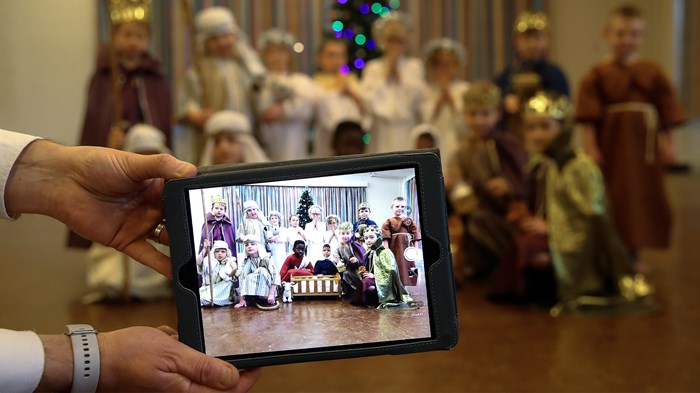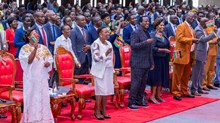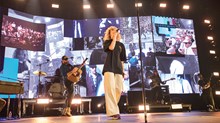
Ask a British person about Nativity plays, and it’s not unlikely that a crustacean will get a mention. Emma Thompson’s slightly incredulous discovery that there was, in fact, more than one lobster present at the birth of Christ—a scene in Love Actually—is a nod to some of the more outlandish consequences of playing with the Christmas story. But the scene also reflects the cherished place the Nativity play continues to hold in British culture.
With Christmas just weeks away, many a parent is likely to be setting aside tea towels to adorn the heads of tiny shepherds, if not sewing eight legs on an octopus.
While precise statistics are hard to come by, polls suggest that Nativity plays remain widespread in schools in the UK. In the years before the pandemic, around 8 in 10 parents reported that their children had taken part in a Nativity play. In 2021, when COVID-19 public health measures were still in place, 81 percent of teachers were still planning to put on a Nativity play, even if it had to be online.
In a typical production, young children will enact the story of Christ’s birth, from the angel’s visit to Mary to the arrival of the wise men. While many are simple retellings in school halls, some entail an impressive degree of stage management.
At Mayfield School, a Catholic boarding school for girls in Sussex, a tradition dating back to the 1950s sees Mary and Joseph journey through the village with a donkey. They are turned away at the local pub before arriving at the school’s 14th-century chapel, with a real baby playing the part of Jesus.
Rob Barward-Symmons, impact and evaluation manager at the Bible Society, describes Nativities as “fascinating moments in the context of British Christianity … this key moment in which a huge proportion of the population are not only hearing Scripture but embodying it and experiencing it. … We do kind of take it for granted.”
For most children and young people in Britain, he observes, “school is the only place where they are going to encounter the Bible.” The vast majority of children—around 94 percent—are educated in state-funded schools. For centuries most schools were run by church authorities, and even today, around a third of England’s state-funded schools are “faith schools,” a majority of which are affiliated with the Roman Catholic Church or Church of England.
Anyone can go to a faith school, although some schools do give priority to children from families that are regular worshipers. (They’re the minority—75 percent of parents of kids under 18 go to church rarely or never.) Most of the 1.9 million pupils taught in state-funded faith schools in England will not attend church outside of school.
Even for the majority not attending a faith school, the classroom will likely be the place they encounter religion through lessons on the subject. Technically, all state-funded schools are required by law to provide an act of “collective worship” that is “broadly Christian” every day, but the extent to which schools comply varies enormously.
While debate about the place of Nativity plays in a multicultural society occasionally arises, they remain popular. A 2020 poll found that 78 percent of the population approved of schools performing them and that around as many had taken part in a Nativity play when they were at school. This is despite the fact that less than two in five of the population identify as Christian.
“They’re a valued rite of passage for parents to share with their children,” Barward-Symmons observes. “This revisiting of this experience that people have gone through.”
The nostalgia factor is something that has been observed at close hand by Lucinda Murphy, who recently completed a PhD exploring Nativity plays. She interviewed four parents whose children had recently performed in a Nativity play in a nonfaith primary school in a multicultural area of North West London.
For one nonreligious parent, it was “seeing your kids doing the stuff you did when you were five” that created a powerful sentimental attachment. A Hindu mother who had attended a Church of England school as a child was keen for her children to “have the same memories,” to know the story she had “learned as a kid.”
Céline Benoit, a senior teaching fellow at Aston University whose work explores how children encounter religion in primary schools, agrees that there is a “huge sense of nostalgia that goes with Nativity plays.”
Her research has led her to conclude that Nativity plays in schools are not primarily about celebrating Christianity and the birth of Jesus. Rather, she suggests, they illustrate the fact that “a certain form of Christianity—a liberal form of Christianity, if you like—is viewed as entwined with Englishness.”
She connects this to research showing that parents often expect schools to teach their children about “the basics of Christianity. … In that way, the learning gets passed on, and it doesn’t have to happen in the home context.”
Nativity plays are viewed less as a religious festival and more as a “cultural performance,” she argues. This is not to detract from parents’ attachment: At her own daughter’s school, nine performances were put on in 2021 to enable as many parents as possible to watch, while obeying COVID-19 health guidelines.
Barward-Symmons agrees that the ubiquity of Nativity plays should not give rise to overconfidence in their evangelistic potential.
“There is the risk of it being perceived as a child’s story equivalent to a fairy story: nice, lovely, and not a space for going into complexities around the Virgin Birth and the depth of the Incarnation,” he observes.
There remains a challenge, he says, to get children to “consider and reflect and think about this story as something that has a deeper truth behind it and is not purely a British cultural tradition.” He wonders how many teachers are encouraging children back to the Bible to read the gospel accounts from which Nativity plays are a “few steps removed.”
Interestingly, a recent national review of religious education—a compulsory subject for state-funded schools—suggested that pupils could study the concept of the Incarnation as part of the Nativity story from the age of five.
In fact, the Bible Society’s own research with children aged 8 to 15 contained some encouraging findings. As of 2014, 71 percent recognized that the Nativity story is in the Bible, while 75 percent had read, heard, or seen it. It was by far their favorite Bible story.
At St Mary’s, a Church of England primary school in East Barnet, an area in north London, a traditional Nativity play is performed every year by the youngest children, while older pupils take part in a more contemporary Nativity production. Last year, they put on Bethlehem Bandits, a musical by Dave Corbett in which a group of bandits fail to steal anything from Mary, Joseph, the wise men, and even the shepherds and decide to change their ways.
Children arrive at the school with “lots of different experiences of faith—some with very little, and some with lots,” says the headteacher, Maria Constantinou, who aims for every pupil “to establish the ability to hold a balanced and well-informed conversation about beliefs and religion, including the Christian faith.”
“As a church school, Nativities are part of our identity,” she told CT.
“It gives the children an opportunity to really experience the story and empathize with what it might have been like for the holy family. We weave our collective worship theme during Advent into this, to support the children to understand how the birth of a tiny baby would change the lives of so many people. A Nativity helps even the youngest members of our St. Mary’s family to know the story of the first Christmas and that it's not all about wrapping paper and presents.”
Nativities are “about people and communities as much as they are about the message of God’s love and Christ’s light and hope,” she says.
Many performances involve an element of audience participation, with parents, grandparents, siblings, and members of the local clergy often present. “There is always laughter at the puns and terrible jokes (‘We must give these camels a rest before they get the hump’),” she observes, “and a few tears of pride, especially when we end the infant Nativity with a beautiful rendition of ‘Away in a Manger.’”
It’s an approach that resembles medieval mystery plays, says Eleanor Parker, lecturer in medieval English literature at Brasenose, a college of Oxford University, who notes that including additional, sometimes comic elements to Nativities is nothing new.
Medieval dramas telling the Christmas story took a “creative approach” that brought the story to life, she says. “In one play, there is a comic storyline in which the shepherds play tricks upon one another. You have a sense of those shepherds as people … characters you can relate to. … It’s quite moving, then, when you see them at the manger, giving their cherries to the baby Jesus.”
While St. Francis is often cited as the originator of the Nativity—he famously used live animals to create the first-ever Nativity scene in Greccio, Italy, in 1223, as a backdrop to his preaching—Parker notes that Nativity plays in schools are a 20th-century invention that arose after a reawakening of interest in medieval mystery plays.
Suppressed at the Reformation, religious plays remained “taboo” for centuries, right through the Victorian period, she explains. This shifted in the early decades of the last century, with a more “open-minded” approach to medieval culture that, rather than dismissing the plays as superstition, recognized them as “lively, interesting, original ways of telling the story.”
While today’s Nativity plays are performed as standalone productions, in the medieval era, the story would have been part of a larger cycle of plays telling the story of Christianity from Creation to Judgment Day, usually during the summer given their outdoor nature. While children may have contributed to the music used in productions, Parker thinks it unlikely that they would have been given the roles they now enjoy in Nativities.
Like Nativity plays, mystery plays were widely accessible, designed to communicate Bible stories through visual performance, and appealing to an audience that was “young and old, literate and nonliterate.” While many contained comedic elements, the entire cycle would not have shied away from the darker elements of the story, including Herod’s persecution, Parker notes.
For Barward-Symmons, the popularity of the modern Nativity play represents a foundation for teachers and others to build upon, to encourage children to ask deeper questions.
“What does it mean for this child born to poor and marginalized parents, who have been kicked out of their homeland, who are ostracized in many ways, to be fully divine, fully human, in the form of this tiny vulnerable infant?” he says.
“What does it mean for Jesus to be visited by wise men or shepherds? To be hunted by Herod? There is the potential for tapping into this well-known story and going, ‘Have another look; look deeper; reflect on it more. It’s something you know, but there’s more to it.’”

Support Our Work
Subscribe to CT for less than $4.25/month


















